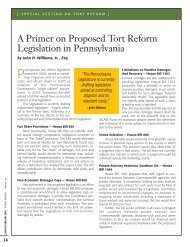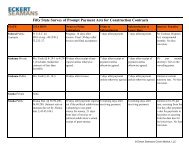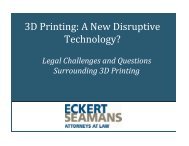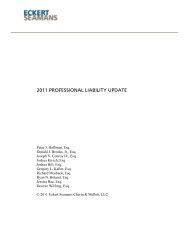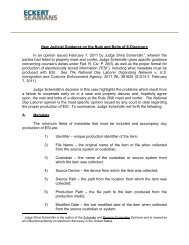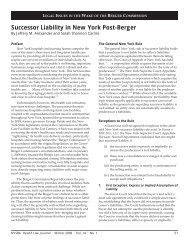2012 PROFESSIONAL LIABILITY UPDATE - Eckert Seamans
2012 PROFESSIONAL LIABILITY UPDATE - Eckert Seamans
2012 PROFESSIONAL LIABILITY UPDATE - Eckert Seamans
Create successful ePaper yourself
Turn your PDF publications into a flip-book with our unique Google optimized e-Paper software.
the need for expert medical testimony. The Superior Court affirmed the trial court’s ordergranting summary judgment in favor of the family practice physician.The Superior Court also, however, found that the trial court had erred in overrulingobjections at trial to the use of an EMS report, which it found to contain inadmissible hearsayand the admission of which could not be justified by reliance on the line of cases that allowstestifying experts to rely, in part, on hearsay opinions contained in medical records notintroduced into evidence. Based on the improper admission of this report, the Superior Courtawarded a new trial to all Defendants involved in the first trial.Subsequently, by Order dated January 2, 2007, the Pennsylvania Supreme Court vacatedthe Superior Court’s ruling and remanded the case to the Superior Court for a determination ofthe responsibility for the absence of transcripts from the record certified for appeal. However,the Supreme Court did not make any substantive rulings. See Papach v. Mercy Suburban Hosp.,914 A.2d 868 (Pa. 2007).(c)What is Enough Proof?In Ellison v. United States, 753 F.Supp. 2d 468 (E.D. Pa. 2010), the District Court foundthe testimony of two expert witnesses reliable in a suit where a patient suffered a stroke afterexperiencing hypotension multiple times during an oral surgery. The court followed the Daubertstandard and applied a liberal and flexible interpretation of Federal Rule of Evidence 702 indetermining the experts’ reliability.Although the standard of care expert conceded that he did not know whether other oralsurgeons would use or disagree with the standard he proposed, and stated “I think it’s the correctway and that’s my opinion” (emphasis added), the court found that the expert had a reliable basisfor setting forth the procedure as the general standard of care and not merely a personal standardof care. The court found the expert’s testimony reliable even though the expert could not pointto any texts that were specifically relevant, because the expert used indirect references thatcorroborated his testimony. The court also found the testimony reliable despite a contradictingtext, because the expert offered a reasonable explanation for his testimony’s divergence with thecontradicting text.The causation expert was the doctor that treated the patient after his stroke, and hetestified that the stroke was cardioembolic and was caused by the episodes of hypotension duringthe patient’s oral surgery. The court found the testimony reliable, and noted that the fact thatthere is no test to definitively determine the cause of a stroke does not make the expert’stestimony unreliable. To determine the cause of the stroke, the expert performed a differentialdiagnosis, which the Third Circuit had previously held as generally reliable.The court agreed with the expert that it is not practical to perform every available test ona patient, and that once a doctor determines a cause of a stroke, the testimony about the cause isnot unreliable simply because the doctor did not perform more tests in search of another cause.Additionally, the expert did not have to determine which episode of hypotension caused the clotthat caused the stroke, because a prima facie case of causation only requires a showing that adoctor’s negligence increased the risk of harm and the patient actually suffered harm. Finally, the13




